SFN: This entry is too good to get lost in the middle of a lot of the news that we’ve had breaking in recent days, so we are moving it back to the front of the blog to make sure that the community sees it.
If your attitude going into this latest entry on financing college sports can be described as “skeptical” or “questioning”, then Part 1 and Part 2 of the series have served their purpose. In this installment, I’ve sliced up the data from Equity in Athletics into relatively small chunks so that we can look at specific areas of interest for the entire ACC.
This entry will feature a lot of tables and relatively little commentary. The next planned entry in this series will feature a more in-depth discussion of sports financing at NC State. The purpose of this entry is mostly intended to put the easily available facts on record and to provide a quick (but potentially flawed) perspective on sports finances across the ACC.
.
.
SUMMARY OF ATHLETIC TEAMS
Let’s start off with a brief summary of the athletic teams fielded by the ACC schools:
– The rifle team at NC State is the only coed team in the conference.
– In men’s sports, all ACC schools field teams in baseball, basketball, football, track, and tennis
– In women’s sports, all ACC schools field teams in basketball, tennis, track, volleyball
NOTE: It appears that all track teams, including cross country, are combined for accounting purposes at EIA for both the men’s and women’s teams.
Additional funded sports for men and women are summarized in the following tables:
“Funded” sports is a bit of a misnomer. Pretty much everyone here knows that the NCAA allows 85 scholarships for football and 13 scholarships for men’s basketball. But the NCAA also has established limits for every sport, some of which make little/no sense. For instance, baseball is allowed 11.7 scholarships. (Wouldn’t you love to know how they came up with a fractional scholarship allotment?) If anyone is interested, I found a list from 2005 on NCAA maximum scholarships that I’ve summarized here.
Weird question of the day: How do they work the meals for an athlete on 1/2 scholarship?
RABBIT TRAIL #1
If you go through UMD’s pages at EIA, you will find cheerleading expenses mentioned several different times…but without its own separate line item. If you pull up the maximum scholarship listing just above, you will see that cheerleading is not included…which I’m assuming means that cheer leading scholarships are not allowed (or maybe recognized) by the NCAA. [Insert rant against fem-nazis here.] Based on the time spent in practices and at games for at least two sports, I see nothing wrong with having the cheerleaders on scholarship and using the numbers (male and female) in the bizarre Title IX calculations/reporting.
If anyone has any specific knowledge about funding for cheerleaders, please educate us in the comments. I do know that the Dance team is listed as a club sport (which means they have to raise whatever funding they need) and this brings us to the next foot note:
RABBIT TRAIL#2:
I had no idea that there were unfunded or club sports at NC State until I went to an NC State hockey match in VA several years ago. In fact, there’s quite a long list of club sports that have been organized at NC State. It appears that these club sports were formed in addition to the intramural leagues that were popular when I was in school. If this impression is wrong, then please correct me in the comments.
.
.
ATHLETIC PARTICIPATION
If you drill down into a school’s data at EIA, you can come up with a list of participants broken down by each sport. The main reason that I mention this breakdown, is that the list shows that the participation numbers includes walk-ons for each sport. (This distinction will become important a little further down.) Here is a summary table breaking down the number of athletes at each school:
Side Rant
From time to time, some idiot (see Vitale, Dick) will start droning on about the need to pay college athletes a stipend to cover expenses beyond tuition, meals, housing, and books. If you feel that way and want to move beyond my “idiot” classification, then at least make some effort to include the total cost of paying all scholarship athletes (or justification for limiting the scope) in your discussion. As we saw with Title IX, if you issue a royal decree to direct athletic dept expenditures, that decree will most likely be met by eliminating existing teams rather than generating more income. [/rant]
In the athletic participation tables at EIA, there is a distinction made between “total athletes” and “unduplicated athletes”. It sounds like the difference between those two totals would be the number of athletes that play more than one sport. While a discussion on two-sport athletes has no effect on our investigation into financing, I’ve included a summary because I found the number of two-sport athletes quite surprising:
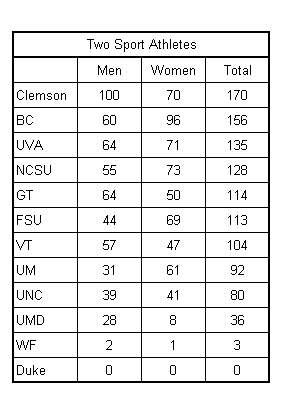
.
.
ATHLETICALLY RELATED STUDENT AID
Here is a table summarizing athletic aid provided by each ACC school:
Since the participation numbers include walk-ons, it is difficult to determine exactly how much an athletic scholarship costs at each school. But by keeping the men’s and women’s calculations separated, we know that the higher of the two numbers will be closer to what a scholarship actually costs. (But even then, the number will probably be low.)
.
.
RECRUITING EXPENSES
I’ve seen comments recently about State not spending enough money on recruiting. I don’t know what those posts were based on, but this table doesn’t support that conclusion.
I was surprised to see GT at the top of of this table. The number gets even more surprising if you look at recruiting expenses on a per athlete basis.
[Insert obligatory strip club comment here.]
.
.
FOOTBALL EXPENSES AND REVENUES
Earlier this year, Tomahawk Nation had an article on football expenses and a discussion tying spending with success. I generally love the work that they do, but didn’t care much for their take on this subject.
If you look over the football expenses/revenues, you will see that BC and UM have the highest FB expenses in the conference. Now consider:
– While we don’t have actual numbers, who would you guess has the highest travel expenses?
– Scroll up to the athletic aid table, and you will see that BC and UM fall near the top of the conference in scholarship cost as well.
– Go back to Part 2 and see where coaching salaries are often obscured in the numbers presented at EIA.
Bottom line:
If you want to talk about recruiting costs and success, I’ll listen.
If you want to talk about head coach’s salary and success, I’ll listen.
If you want to talk about assistant coaches combined salaries and success, I’ll listen.
But I’m not interested in talking about total expenditures and success.
I would really like to pull back the layers and look at a number of those issues, but the numbers simply aren’t available. However, UNC and NCSU have essentially the same scholarship costs and should have roughly the same travel expenses….so how do these two schools compare?
Now I know that the Chief has had to endure a lot of medical hardships to non-starters, but I would love to have a detailed explanation of this table. It just seems that at some point, penny pinching is going to affect the product put out on the field. I would love to know where that point is and where State falls in relation to that point.
.
.
MEN’S and WOMEN’S BASKETBALL EXPENSES AND REVENUE
I was surprised to see that Duke’s BB program ended up in the red. If you flashback to our annual discussions on OOC strength of schedule, Duke’s is always near the top in the conference while State’s is always near (or at) the bottom. I wonder if State just schedules the cheapest opponents possible? (Presuming of course that there is SOME reason for State’s ridiculous schedule year after year.)
Observations:
1) It looks like BC’s accounting practices in men’s and women’s basketball are two more examples of how things are reported differently from school to school.
2) It doesn’t appear that GT and WF have included scholarship funding as revenue for the women (and thus probably not for any of their teams). This difference illustrates once again that there are no consistent rules for the financial reporting summarized at EIA.
3) How many rants have you read over the years about the evils of big-time college athletics or a discussion about the “absurd” salaries paid to the top college football and basketball coaches. With all of the concern about spending on college sports, have you ever read a rant about the money that is spent on women’s basketball with virtually no revenue generated? I wonder why not?
4) I’ve often wondered exactly why the expenses for women’s basketball are so much higher than for the other non-revenue sports. Other than out-right waste, the only thing that I’ve ever thought of is that the travel expenses (ie flying to nearly every game?) are much higher than for the other sports. Any thoughts?
.
.
EXPENSE AND REVENUE TOTALS
Wouldn’t you love to see a break down of the miscellaneous columns?
.
.
CLOSING THOUGHTS
Dave Glenn is not on my list of approved information sources, so I would have missed this interview with Debbie Yow if not for a posting in our forums. Listening to this interview is what gave me the push to start on this series since it confirmed some of my suspicions. It also serves as a nice segue into the next installment which will focus on a more detailed discussion on NCSU finances.
I’ve transcribed the important parts of the interview (starts at around the six minute mark):
Part of DY’s response to a generic “first impressions†question:
…One thing right off the bat is that their budget is one of the smallest budgets that I’ve ever seen per sports expenditure. That’s how I would judge it for 23 sports. This is very lean, I would say too lean [of an] operation. We’ll work on that and see how we can generate some additional revenues…
DG’s follow-up comment/question:
When we look at the big picture of college athletics, obviously booster donations are a big part of paying all of the bills these days. We know on the one hand that NC State has one of the most populated booster organizations. But we know on the other hand in terms of total dollars, that the Wolfpack is not as high on that list. How can you change that equation where you keep the passion and the participation, but you raise even more money?
DY’s response:
Well I don’t think any of us know how much money is raised every year. I mean, how do we know that? The Wolfpack Club is separately incorporated. So at some point I’ll visit with their leadership and with Bobby Purcell and others and try to get a better understanding of exactly how much money is coming in every year because I really don’t know that right now. I only know what the transfer is for scholarships which would not represent the total amount of money that is coming in from fans for the athletic programs.
Past history has shown that trying to direct comments down a specific path is about as effective as herding cats. However, the next installment will focus on a more in-depth discussion on sports finances specifically at NC State. Most comments/questions specifically about NC State’s finances should probably be held until the next entry.


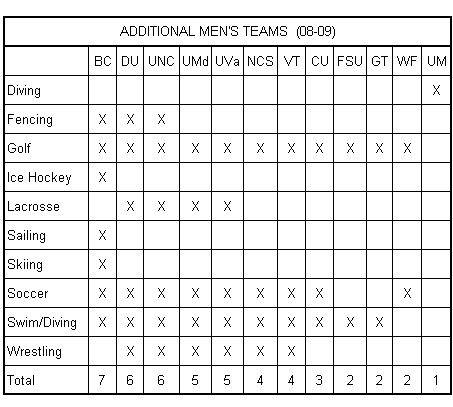
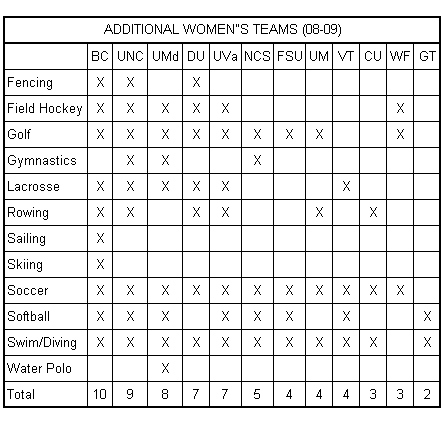
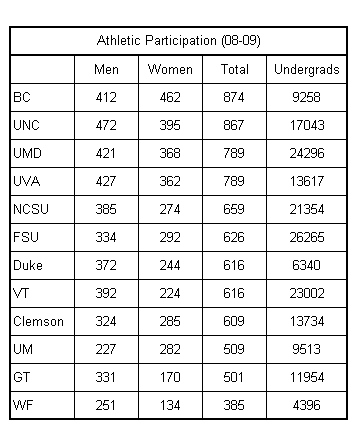
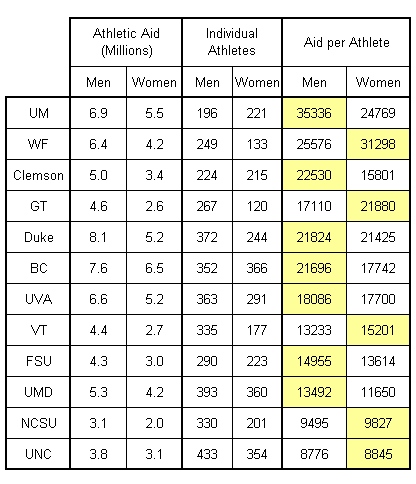
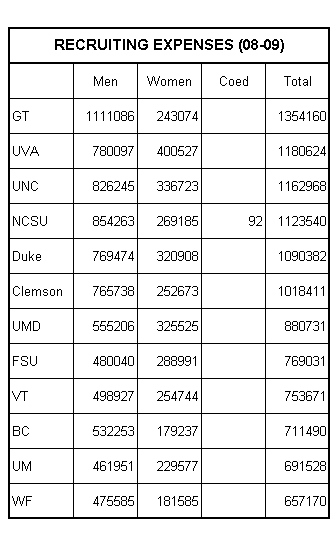
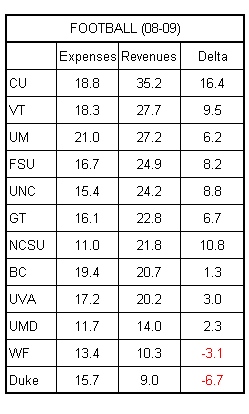
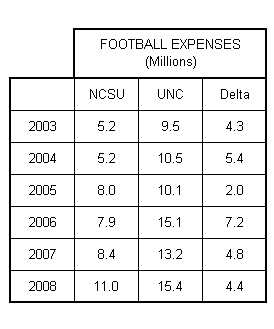
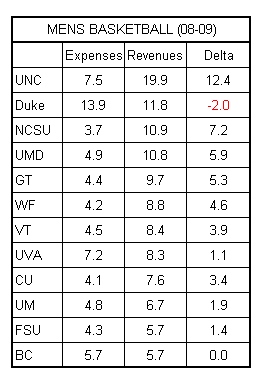
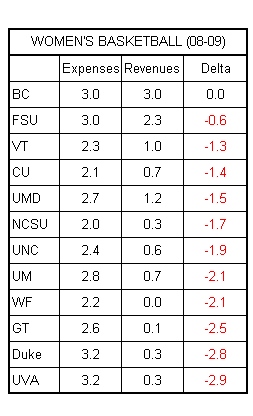
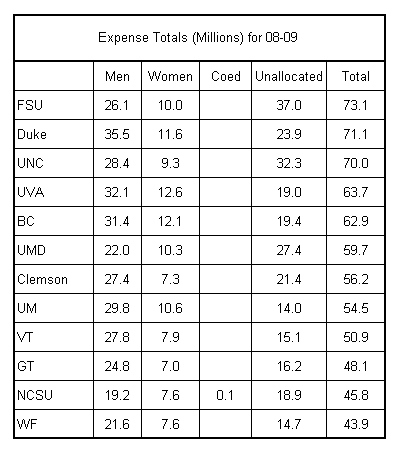
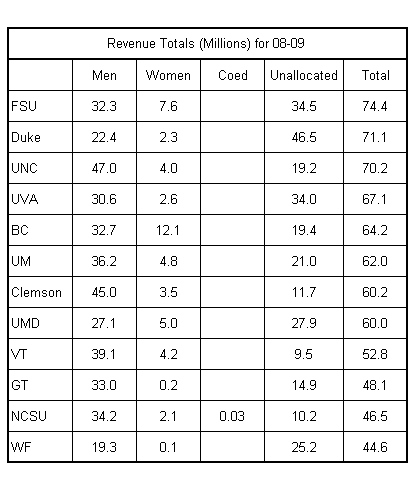

You must be logged in to post a comment.